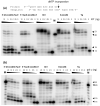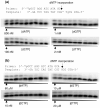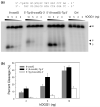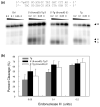In vitro replication and repair studies of tandem lesions containing neighboring thymidine glycol and 8-oxo-7,8-dihydro-2'-deoxyguanosine
- PMID: 19193190
- PMCID: PMC2765499
- DOI: 10.1021/tx8003449
In vitro replication and repair studies of tandem lesions containing neighboring thymidine glycol and 8-oxo-7,8-dihydro-2'-deoxyguanosine
Abstract
Reactive oxygen species can induce the formation of tandem DNA lesions. We recently showed that the treatment of calf thymus DNA with Cu2+/H2O2/ascorbate could result in the efficient formation of a tandem lesion where a 5,6-dihydroxy-5,6-dihydrothymidine (or thymidine glycol) is situated on the 5' side of an 8-oxo-7,8-dihydro-2'-deoxyguanosine (8-oxodG). In the present study, we assessed how the 5'-Tg-(8-oxodG)-3' and 5'-(8-oxodG)-Tg-3' tandem lesions are replicated by purified DNA polymerases and how they are recognized by base excision repair enzymes. Our results revealed that the tandem lesions blocked primer extension mediated by the Klenow fragment and yeast polymerase eta more readily than when the Tg or 8-oxodG was present alone. The mutagenic properties of Tg or 8-oxodG differed while they were present alone or in tandem. Moreover, the human 8-oxoguanine-DNA glycosylase (hOGG1)-mediated cleavage of 8-oxodG was compromised considerably by the presence of a neighboring 5' Tg, whereas the presence of Tg as the adjacent 3' nucleoside enhanced 8-oxodG cleavage by hOGG1. The efficiency for the cleavage of Tg by endonuclease III was not affected by the presence of an adjoining 8-oxodG. These results supported the notion that the replication and repair of tandem single-nucleobase lesions depend on the types of lesions involved and their spatial arrangement.
Figures





Similar articles
-
Efficient formation of the tandem thymine glycol/8-oxo-7,8-dihydroguanine lesion in isolated DNA and the mutagenic and cytotoxic properties of the tandem lesions in Escherichia coli cells.Chem Res Toxicol. 2010 Jan;23(1):11-9. doi: 10.1021/tx9004264. Chem Res Toxicol. 2010. PMID: 20014805 Free PMC article.
-
Synthesis and thermodynamic studies of oligodeoxyribonucleotides containing tandem lesions of thymidine glycol and 8-oxo-2'-deoxyguanosine.Chem Res Toxicol. 2006 Jun;19(6):837-43. doi: 10.1021/tx060032l. Chem Res Toxicol. 2006. PMID: 16780363 Free PMC article.
-
Mutagenic potential of 8-oxo-7,8-dihydro-2'-deoxyguanosine bypass catalyzed by human Y-family DNA polymerases.Chem Res Toxicol. 2014 May 19;27(5):931-40. doi: 10.1021/tx500088e. Epub 2014 May 5. Chem Res Toxicol. 2014. PMID: 24779885 Free PMC article.
-
Salvage of oxidized guanine derivatives in the (2'-deoxy)ribonucleotide pool as source of mutations in DNA.Mutat Res. 2010 Nov 28;703(1):11-7. doi: 10.1016/j.mrgentox.2010.08.021. Epub 2010 Sep 15. Mutat Res. 2010. PMID: 20833264 Free PMC article. Review.
-
The Intertwined Role of 8-oxodG and G4 in Transcription Regulation.Int J Mol Sci. 2023 Jan 19;24(3):2031. doi: 10.3390/ijms24032031. Int J Mol Sci. 2023. PMID: 36768357 Free PMC article. Review.
Cited by
-
Vicinal abasic site impaired processing of a Tg:G mismatch and 8-oxoguanine lesions in three-component bistranded clustered DNA damage.RSC Adv. 2018 May 16;8(32):17921-17926. doi: 10.1039/c8ra01992d. eCollection 2018 May 14. RSC Adv. 2018. PMID: 35542077 Free PMC article.
-
DNA sequence context effects on the glycosylase activity of human 8-oxoguanine DNA glycosylase.J Biol Chem. 2012 Oct 26;287(44):36702-10. doi: 10.1074/jbc.M112.397786. Epub 2012 Sep 18. J Biol Chem. 2012. PMID: 22989888 Free PMC article.
-
A perspective on tumor radiation resistance following high-LET radiation treatment.J Cancer Res Clin Oncol. 2024 May 2;150(5):226. doi: 10.1007/s00432-024-05757-8. J Cancer Res Clin Oncol. 2024. PMID: 38696003 Free PMC article. Review.
-
Mutagenic Effects of a 2-Deoxyribonolactone-Thymine Glycol Tandem DNA Lesion in Human Cells.Biochemistry. 2020 Feb 4;59(4):417-424. doi: 10.1021/acs.biochem.9b01058. Epub 2019 Dec 30. Biochemistry. 2020. PMID: 31860280 Free PMC article.
-
Delayed repair of radiation induced clustered DNA damage: friend or foe?Mutat Res. 2011 Jun 3;711(1-2):134-41. doi: 10.1016/j.mrfmmm.2010.11.003. Epub 2010 Dec 2. Mutat Res. 2011. PMID: 21130102 Free PMC article. Review.
References
-
- Finkel T, Holbrook NJ. Oxidants, oxidative stress and the biology of ageing. Nature. 2000;408:239–247. - PubMed
-
- Nikjoo H, O’Neill P, Wilson WE, Goodhead DT. Computational approach for determining the spectrum of DNA damage induced by ionizing radiation. Radiat. Res. 2001;156:577–583. - PubMed
-
- Sutherland BM, Bennett PV, Sutherland JC, Laval J. Clustered DNA damages induced by x rays in human cells. Radiat. Res. 2002;157:611–616. - PubMed
-
- Budworth H, Dianov GL. Mode of inhibition of short-patch base excision repair by thymine glycol within clustered DNA lesions. J. Biol. Chem. 2003;278:9378–9381. - PubMed
Publication types
MeSH terms
Substances
Grants and funding
LinkOut - more resources
Full Text Sources
Research Materials
Miscellaneous

